#brake pedal reinforcement
Explore tagged Tumblr posts
Text
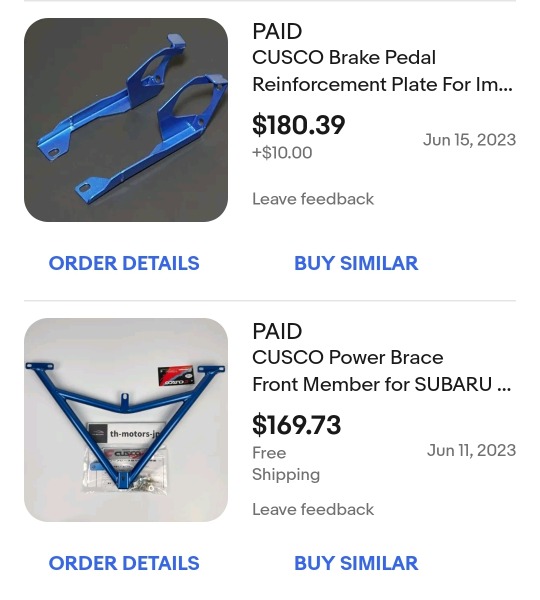
Recently sold one of my bikes so I used some of the cash to buy these 2 parts made by Cusco. Why are the prices similar when the brake pedal reinforcement has way less metal?
I have a feeling both parts are gonna be a PITA to install. They are not listed to fit the 2nd gen Legacy but my eyeballs tell me otherwise. Coming from Japan so it will be a couple weeks.
Why spend that much? Because they both are more of a safety thing for me with the bonus of handling/performance benefits. The car has no brake booster so one part reinforces the firewall from the cabin side, equals a more solid pedal and less stress on the firewall. The car also needed something other than the JDM toothpick of a bumper beam in case of a head on collision.
@deepenter The brake pedal reinforcement plate is something you might try? ✌️
Cusco part numbers:
GC8 Impreza front power brace: 660-492-FM
GD Impreza brake pedal reinforcement plates:
CG 667 486 A
#subaru#cusco#car parts#legacy#impreza#gc8#gda#bk6#thoughts#bracing#brake pedal reinforcement#jdm#custom#modified cars#part numbers
6 notes
·
View notes
Text

Le Petit écho de la mode, no. 28, vol. 33, 9 juillet 1911, Paris. Bicycle advertisement. Ville de Paris / Bibliothèque Forney
DESCRIPTION. — Cadre et fourche en tubes d’acier étiré, sans soudure, renforcés à tous les raccords. — Pièces de direction nickelées, en acier décolleté. — Guidon à serrage par expandeur.— Pédalier à réglage indesserrable par bagues coniques et concentriques. — Manivelles acier forgé à grande résistance. — Pédales à scie avec entretoises. — Pignon acier laminé, modèle déposé, 52 dents, au pas de 12-7. — Moyeux à cônes indéréglables. — Jantes acier à bords nickelés. — Rayons tangents renforcés, marque “Etoile”. — Roue libre Eadie véritable, à 2 rangées de billes. — Frein de sûreté sur la roue avant. — Frein sur la jante arrière, licence Bowden. — Chaîne acier, supérieure, au pas de 12-7. — Garde-boue érable poli et verni. — Selles, 4 spires à 4 fils nickelés. — Sacoche garnie de tous les accessoires. — Email noir très soigné. Nickel extra 1er titre sur cuivre. — Poids en ordre de marche : 13 kilos.
DESCRIPTION. — Frame and fork in drawn steel tubes, without welding, reinforced at all joints. — Nickel-plated steering parts, in machined steel. — Handlebar with expander clamping. — Crankset with unloosenable adjustment by conical and concentric rings. — High-strength forged steel cranks. — Saw pedals with spacers. — Rolled steel pinion, registered design, 52 teeth, 12-7 pitch. — Hubs with unadjustable cones. — Steel rims with nickel-plated edges. — Reinforced tangent spokes, “Etoile” brand. — Genuine Eadie freewheel, with 2 rows of ball bearings. — Safety brake on the front wheel. — Brake on the rear rim, Bowden license. — Steel chain, upper, 12-7 pitch. — Polished and varnished maple mudguards. — Saddles, 4 coils with 4 nickel-plated wires. — Bag with all accessories. — Very neat black enamel. Extra nickel 1st grade on copper. — Weight in working order: 13 kilos.
#Le Petit écho de la mode#20th century#1910s#1911#on this day#July 9#periodical#advertisement#description#Forney#bicycle
11 notes
·
View notes
Photo



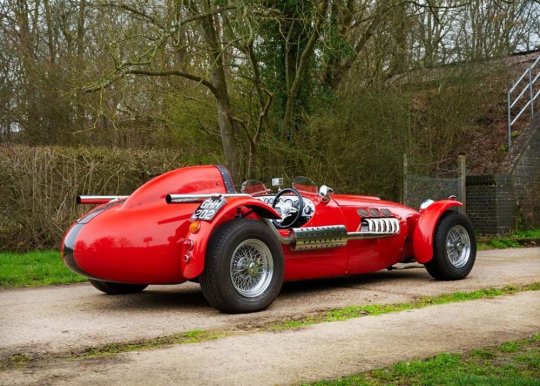
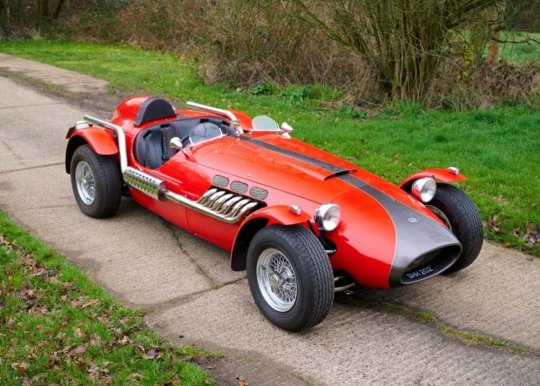

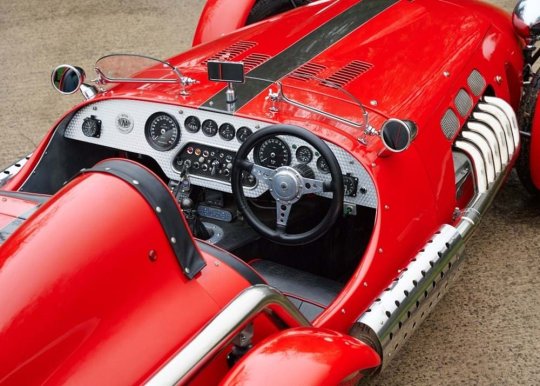
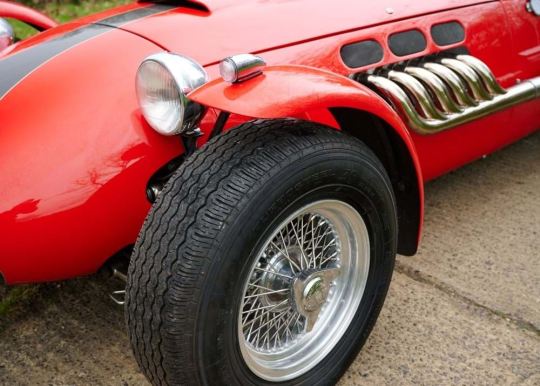


Ronart W152 MK.II
The W152 was the first car to be designed and built by Ronart Cars, which was founded in 1984 by Rona and Arthur Wolstenholme and launched at the 1985 International Classic Car Show, with production commencing the following year. Of original conception, the design was intended to reflect the style of the front-engined Formula One cars of the 1950s, of which the humped headrest and external exhaust are typical ingredients. The car is built around a backbone chassis and clothed in an 11-piece body comprising: centre tub section, nose cone, bonnet, front side panels, rear section, boot lid and quartet of cycle wings. The centre section is reinforced with a steel cage, to which a roll-over bar is firmly attached; the tip of which is cunningly secreted under the driver's head rest. On Mk. II versions, such as the sale car, a boot is built into the rear section. This stunning British sports car is presented in racing red with carbon stripes and a black leather interior piped in red. The bodywork on this particular example is carbon fibre which we believe to be unique and clearly provides this car with a substantial weight advantage against its rivals. It is fitted with a Jaguar six litre V12 sport engine which is fuel injected with high-impedance fuel injectors, emerald management system with V12 map installed. It also has a power lock 3.07 differential, fully adjustable pedal box, Willans four-point harness, Le Mans fuel filler, boxed gel battery, three stage trickle charger and Brooklands aero screens. It has stainless steel headlights and sidelights, fully independent suspension with adjustable coil over shocks, AP racing brakes and calipers and wire wheels. Also, the car was set up to do rallying and therefore it does have the relevant timing equipment fitted.
64 notes
·
View notes
Text

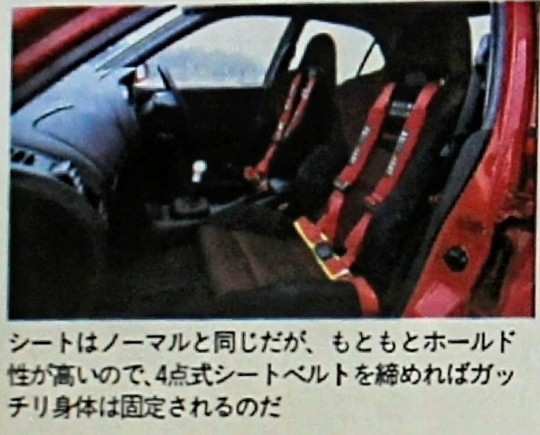
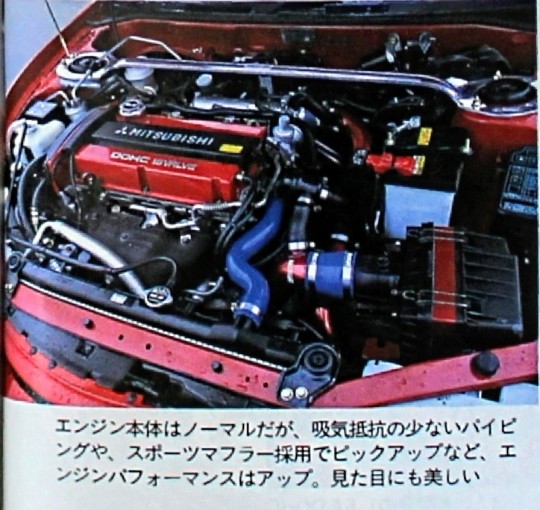

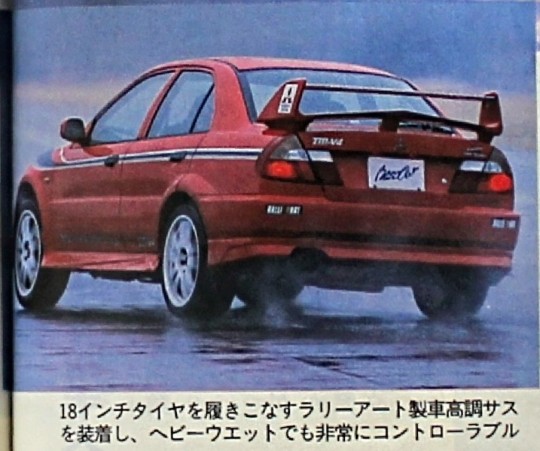
Ralliart tuned street version EVO. Tommy Makinen TM-V4
Lancer Evolution TM-V4
Ralliart fine changes EVO.
For a stronger evo
Numb!!!
Report/ Motonobu Takehira
Based on the Lancer EVO 6 Tommy Makinen Edition, a model tuned by Ralliart incorporating sports parts has appeared. That is the TM-V4, a street model based on the GSR, equipped with plenty of Ralliart sports parts and aiming for further improvements. Not a so-called complete car. Instead, it will be a tuning model that incorporates parts developed by Ralliart.
First of all, looking at the exterior, the side aero spoilers, which are larger than the normal ones, are noticeable, but the rest of the car doesn't look any different from the normal ones. Isn't it?
The tires are Michelin Pilot Sport 235/40ZR18. This is expected to increase the potential of exercise performance on winding roads.
If you look at the cockpit, you won't feel any difference from the normal one, but the 300km/h scale white triple meter, Carbon look panel on centre console and polyacetal shift knob increase rally mood.
Suspension is equipped with a shock absorber that can adjust the damping force (4 levels), and a vehicle height adjustment type with series springs (5 kg for both front and rear). It has aluminum tower bars on the front and rear. The brakes are reinforced with stainless mesh hoses, master cylinder stoppers, and sports pads.
And although the engine is worrisome, the main body is normal. However, motor sports improved exhaust efficiency. A muffler, piping that smoothes the air flow in the intake system, a sports type air cleaner, etc. are used to smooth the flow of intake and exhaust, and the sports ECU manages the engine.
When you open the hood, the dull black pipes have been changed to bright blue and red pipes, and just looking at them is exciting. It is also a part of Ralliart that is beautifully put together.
Running is a high-level unity ◎!!
Well, what about the running!?!?! I wrote that the engine itself is normal, but isn't it powered up? In particular, you can clearly feel the power increase in the middle and high rotation range. The response to the accelerator is sharper in the entire range, and the top end is even better. By the way, the boost is up by about 0.1 kg/cm. Isn't it about 30 horsepower increased!?!?!
No problems with drivability. Torque may be lower than normal at low revs, but there is no practical problem at all. Same smoothness as NORMAL, same ease of handling. The suspension is also perfectly decided
Wider for higher grip
Even if the tires are bumped and the road is uneven It is well demonstrated. Hardness
It is also exquisite, and the ride comfort is properly secured, so it can be used well on the street. The damping force to the shock absorber was set to 3 stages both front and rear, but this is the best setting for general winding.
You can enjoy sharp handling and improved cornering performance.
Brakes are high even at normal running. I felt a sense of rigidity, but this guy is even more solid. Efficacy that responds linearly to pedal force,
There is no perfect touch.
TM-V4 is a radical tuner
Although it is not a driving model, you can definitely enjoy the performance and enjoyment of riding on a higher rank without sacrificing comfort.
I think Lancer Evo owners will enjoy using these parts and tuning step-by-step.
Photographed by Tadashi Saito
PIC CAPTIONS
Equipped with a Ralliart damper suspension that can handle 18-inch tires, it is extremely controllable even in heavy wet conditions.
The engine itself is normal, but the engine performance has been improved with piping that reduces intake resistance and a pickup with a sports muffler. beautiful to look at
A 300km/h scale white meter, polyacetal sports shift knob, carbon-like console panel, and triple gauges give it a unique look.
The seat is the same as the normal seat, but it has a high holdability, so if you tighten the 4-point seat belt, your body will be firmly fixed.

22 notes
·
View notes
Text
Makin' & Stealin'
I think it's okay if I say that I Stole Your Love picks up right where Makin' Love left off, once apart from their positionings on Rock and Roll Over as the last song and on Love Gun as the first.
And once apart from the fact that both actually ride around on basically the same riff in only small variations and both diligently work themselves off with it properly. How would you call that? Are these sibling songs, or rather continuing songs? I would love to write something about sequel songs, but let's just take it as it comes today.
So in this case I try to emphasize more the differences despite the high degree of relationship of the riffs. While Makin' Love suggests highly dynamic joy of movement, it nevertheless gives the impression that it doesn't really want to leave the spot, and that it is more or less frozen with the feet on the ground, and in joyful but equally monotonous up-and-down movements essentially busy with itself. And that's just the guitar riff. The drums reinforce this impression even more and are just as playful as the guitars and everything else, on the one hand, but somehow also keep one foot on the gas pedal and the other just as much on the brakes, and always seem to get bogged down in gear changes and unnecessary clutches. It's a bit like a bucking sports car on the road and sputtering in circles while the engine makes the most wonderful and horrible noises simultaneously that a car lover can imagine.
But away with the car comparison. I Stole Your Love, on the other hand, has little trouble using its legs for more than just turning around on the spot. An healthy attitude that is supported by the drums from the very first bar. Here, the dramaturgy is completely different, and accordingly, there's a lot more drama, which may be due to the much punchier weight shifting, and gives I Stole Your Love a lot more breathing room in its busy dynamics. Much more varied than Makin' Love, it adopts several poses at once, enabling it to assert itself clearly in more than one position and pick up speed just as quickly. I Stole Your Love doesn't prop itself up, as Makin' Love does somewhat too monotonously, but rather pushes itself off and clearly uses the resulting energy to its advantage. And what an advantage it is.
You can think what you want about my words, for me personally I think these two songs are among the best as well as my absolute favorite Kiss songs, and what could possibly be bad about them at all? The thing is, I can see one riff in both songs and yet paint two completely different pictures of them. Whether that represents an identity of their own, capable of confidently conquering originality within its own parameters, or ultimately just stealing everything that isn't nailed down.
At the end of the day, I don't really care, and it doesn't matter at all. Or does it? (1)
Side Note:
(1) Led Zeppelin and Deep Purple are not the issue here today… but inevitably they will be, sooner or later.
Three, two, one... You should have pressed Play by now. What is stopping you from doing this?
Makin' Love (1976)
youtube
I Stole Your Love (1977)
youtube
#Kiss#Paul Stanley#Sean Delaney#Rock and Roll Over#Love Gun#Makin' Love#I Stole Your Love#Eddie Kramer#1976#1977#Roland Rockover#Youtube
2 notes
·
View notes
Text
Group Bike Lessons for Children in NYC: A Fun and Safe Way to Learn
In a bustling city like New York, cycling can be an exciting and practical skill for children to learn. Group bike lessons for children in NYC not only provide essential riding skills but also promote safety, confidence, and social interaction. This article explores the benefits of group bike lessons, what to expect, and how these programs can enrich children’s lives.

The Importance of Learning to Bike
Learning to ride a bike is a rite of passage for many children, offering numerous physical and emotional benefits. In a city with extensive bike paths and parks, it’s crucial for kids to gain these skills early on.
1. Physical Fitness
Cycling is one of the best ways for children to stay engaged in physical activity. It helps improve cardiovascular health, builds muscle strength, and enhances coordination. Group bike lessons for children in NYC encourage regular exercise in a fun and engaging way, combating the sedentary lifestyle that often accompanies screen time.
2. Independence and Confidence
Mastering bike riding instills a sense of accomplishment in children. Group lessons create a supportive environment where kids can encourage each other, leading to increased self-confidence. As they learn to ride independently, they gain a valuable skill that promotes freedom and exploration.
Benefits of Group Lessons
Group bike lessons offer unique advantages that individual lessons may not provide.
1. Social Interaction
One of the primary benefits of group lessons is the opportunity for socialization. Children learn alongside their peers, forming friendships and developing teamwork skills. This camaraderie can make learning to ride a bike more enjoyable and less intimidating, especially for beginners.
2. Structured Learning Environment
Group lessons often follow a structured curriculum designed by experienced instructors. This ensures that all essential skills—such as balance, steering, and braking—are covered comprehensively. Instructors can tailor activities to suit different skill levels, allowing every child to progress at their own pace.
3. Safety Awareness
Riding a bike in a busy city like NYC requires an understanding of safety rules and regulations. Group lessons typically emphasize safe riding practices, such as wearing helmets, signaling, and navigating traffic. Children learn these critical safety skills in a controlled environment, which they can apply when riding in real-world scenarios.
What to Expect in Group Bike Lessons
When enrolling a child in group bike lessons, parents can expect a supportive and educational atmosphere.
1. Skill Assessment
Instructors often begin with a skill assessment to gauge each child’s riding abilities. This helps them group children with similar skill levels and ensures that everyone receives appropriate instruction.
2. Fun and Engaging Activities
Lessons are designed to be fun and interactive. Instructors use games and challenges to teach essential skills, keeping children engaged while they learn. This approach helps break down barriers and makes learning less stressful for those who may feel apprehensive about riding.
3. Progressive Learning
Group bike lessons for children in NYC usually follows a progressive learning model. Children start with basic skills, such as balancing and pedaling, and gradually move on to more complex techniques like turning and stopping. This method allows for steady improvement and reinforces each child’s sense of accomplishment.
4. Parental Involvement
Many programs encourage parental involvement, allowing parents to participate in the learning process or attend sessions. This creates an opportunity for families to bond while fostering a supportive environment for children.
Finding Group Bike Lessons in NYC
Parents interested in enrolling their children in group bike lessons can find various programs throughout New York City. Local community centers, parks, and biking organizations often offer classes tailored to different age groups and skill levels. Additionally, parents can explore online resources and community bulletin boards for recommendations and schedules.
Conclusion
Group bike lessons for children in NYC provide an excellent opportunity for kids to develop essential cycling skills in a safe, fun, and social environment. By fostering physical fitness, independence, and safety awareness, these lessons contribute significantly to a child’s overall development. As children learn to navigate the vibrant streets of NYC on two wheels, they gain confidence and a sense of adventure that will serve them well throughout their lives. Investing in group bike lessons is a step toward promoting healthy habits and lifelong enjoyment of cycling.
#Group bike lessons for children nyc#NYC bike riding classes for kids#Bike riding lessons for children and adults nyc#Group bike lessons for adults nyc#Bike riding lessons near me#Bike riding for adults in NYC#Group bike riding for children nyc#Bike rides for children and adults brooklyn
0 notes
Text
Preparing for Your Nova Scotia Driving Test: Practice Questions & Strategies
Getting ready for your Nova Scotia driving test can be an exciting yet nerve-wracking experience. The test assesses your knowledge of road rules, traffic signs, and safe driving practices to ensure you're prepared for the responsibilities of being on the road. This guide offers a comprehensive look at practice questions and strategies to help you pass your driving test with confidence.
Understanding the Nova Scotia Knowledge Test
The Nova Scotia knowledge test is a written exam designed to test your understanding of the province’s driving laws, road signs, and safety guidelines. It consists of multiple-choice questions that cover various driving topics, including right-of-way rules, speed limits, road signs, and safe driving techniques.
The best way to prepare is by practicing common questions and becoming familiar with the test format. Here are key areas you should focus on:
1. Road Signs
Road signs are crucial in navigating Nova Scotia’s roadways. The test will include questions on:
Regulatory Signs: Stop signs, yield signs, speed limits, and no-entry signs.
Warning Signs: Curve ahead, pedestrian crossings, animal crossing, and sharp turns.
Informational Signs: Directional signs, rest areas, and highway exits.
Practice Question Example:
Q: What does a yield sign mean?
A: You must slow down and be prepared to stop if necessary to let other vehicles or pedestrians pass.
Study Tip: Use flashcards to help memorize different road signs and their meanings. Review the Nova Scotia Driver's Handbook for detailed descriptions.
2. Rules of the Road
Knowing the rules of the road is essential for both the written test and practical driving. Focus on the following topics:
Right-of-Way: Understanding who has the right-of-way in different situations, such as four-way stops, pedestrian crossings, and roundabouts.
Speed Limits: Be aware of the speed limits in residential areas, school zones, and highways.
Safe Driving Distance: Learn how to maintain a safe following distance in different driving conditions.
Practice Question Example:
Q: When two vehicles arrive at a four-way stop at the same time, who has the right-of-way?
A: The vehicle on the right has the right-of-way.
Study Tip: Take practice quizzes to test your knowledge of road rules and traffic scenarios. This helps reinforce your understanding and prepares you for real-world situations.
3. Safe Driving Practices
Safe driving is a central focus of the test. You should know how to handle various driving conditions, including:
Winter Driving: Nova Scotia’s weather can be unpredictable, so understanding how to drive on snow and ice-covered roads is important.
Emergency Situations: Be prepared to handle situations like brake failure, skidding, or sudden stops.
Defensive Driving: Learn techniques for defensive driving, such as scanning the road ahead, adjusting speed in hazardous conditions, and anticipating the actions of other drivers.
Practice Question Example:
Q: What should you do if your vehicle begins to skid on an icy road?
A: Take your foot off the gas pedal, steer in the direction you want to go, and avoid using the brakes.
Study Tip: Review the section on safe driving in the Nova Scotia Driver's Handbook and practice defensive driving tips in everyday driving.
4. Traffic Violations and Penalties
Understanding traffic violations and their penalties is important for responsible driving. Topics include:
Distracted Driving: Nova Scotia has strict laws against texting or using handheld devices while driving.
Driving Under the Influence: Know the penalties for driving under the influence of alcohol or drugs.
Speeding Violations: Be aware of how speeding can affect your driving record and result in fines or license suspensions.
Practice Question Example:
Q: What is the fine for using a handheld device while driving in Nova Scotia?
A: The fine can range from $233 to $578, along with demerit points on your driving record.
Study Tip: Familiarize yourself with the fines, penalties, and demerit points for common traffic violations in Nova Scotia.
Top Strategies for Success
Use Practice Tests: Online practice tests help you familiarize yourself with the types of questions you'll encounter. Aim to take multiple tests to cover a variety of topics.
Study the Driver's Handbook: The Nova Scotia Driver's Handbook is the official guide for the knowledge test. It covers everything you need to know about driving rules, road signs, and safety practices.
Simulate Test Conditions: When practicing, set a timer to simulate real test conditions. This will help you manage your time effectively during the actual exam.
Stay Calm on Test Day: On the day of the test, make sure you're well-rested and arrive early. Take your time answering each question, and don’t rush through the exam.
Conclusion
Preparing for your Nova Scotia driving test doesn’t have to be stressful. By focusing on key topics like road signs, rules of the road, safe driving practices, and traffic violations, you can confidently approach the test. With ample practice and a thorough review of the Nova Scotia Driver's Handbook, you’ll be well on your way to passing your driving test and getting your license.
0 notes
Text
What Are Brake Rotors and How Do They Work?

Brake rotors are a critical component of your vehicle’s braking system. Understanding how they function and when they need replacement is essential for maintaining your car’s safety and performance.
What Are Brake Rotors?
Brake rotors, also known as brake discs, are metal discs attached to the wheel hubs. When you press the brake pedal, the brake pads clamp down on these rotors, creating friction that slows the wheels and eventually stops the car. Rotors are typically made from cast iron or composites like reinforced carbon-carbon or ceramic-matrix, chosen for their durability and heat resistance.
How Do Brake Rotors Work?
When you apply the brakes, hydraulic pressure forces the brake pads against the spinning rotors. This contact generates friction, converting the kinetic energy of the moving vehicle into heat. The heat dissipates through the rotors, which helps prevent the brakes from overheating. The smooth operation of this process is vital for effective braking.
Over time, brake rotors can wear down, develop grooves, or become warped due to heat and constant friction. This wear can lead to reduced braking efficiency, longer stopping distances, and vibrations when braking. When these issues arise, brake rotor replacement is necessary to restore the braking system's optimal performance.
Signs You Need Brake Rotor Replacement
Vibrations: A pulsing sensation in the brake pedal indicates warped rotors.
Noisy Braking: Squealing or grinding sounds can signal worn-out rotors.
Visible Damage: Grooves, scoring, or rust on the rotors suggest they need replacing.
Regular maintenance is key to keeping your braking system in top condition. Many vehicle owners are turning to mobile mechanics for the convenience of on-the-spot repairs and maintenance, including brake rotor replacement. These professionals offer mobile oil change services and other essential automotive care right at your home or workplace, saving you time and the hassle of visiting a traditional shop.
Why Mobile Services Are a Game-Changer
With the growing demand for convenience, mobile services like mobile mechanics are becoming increasingly popular. These services bring the expertise of a repair shop directly to you, whether you need a brake rotor replacement or a routine oil change. Mobile oil change services, for example, ensure your engine stays lubricated and running smoothly without you ever needing to leave your driveway.
Conclusion
Understanding brake rotors and their role in your vehicle's braking system is crucial for maintaining safety on the road. When you notice signs of wear or damage, timely brake rotor replacement is essential. Opting for mobile mechanic services, including mobile oil changes and brake repairs, can make vehicle maintenance more convenient and efficient, keeping your car in peak condition with minimal disruption to your schedule.
0 notes
Text
8 Things to Consider Before Riding a Balance Bike – Kids On Wheelz
Learning to ride a balance bike is an exciting milestone in a kid's development. These pedal-less bikes offer a safe and fun way for toddlers and young children to develop essential coordination and balance skills, laying the foundation for future cycling adventures.
Kids on Wheelz is a leader when it comes to choosing the best toodler balance bikes in Canada.
In this blog, we'll explore a few things that will help your kid master the art of riding a balance bike with confidence and joy.
1. Select the Proper size for Balance Bike
Before embarking on their balance bike journey, ensure that the bike is appropriately sized for your kids. Their feet should comfortably touch the ground while sitting on the saddle, allowing them to maintain stability and control. At Kids on Wheelz, you can find balance bikes for kids depending on their age and choose a proper fit. Adjust the height if needed, as per your kids' needs.
2. Practise Balance and Striding
Encourage your child to straddle the bike and walk while pushing themselves forward with their feet. This helps them get accustomed to the sensation of balancing on two wheels and builds confidence in their ability to control the bike's movements.
3. Choose a Suitable Riding Surface
Begin practising on a flat, smooth surface free from obstacles or hazards. An empty parking lot, driveway, or paved path in a park are ideal locations for your child to gain confidence and refine their balancing skills without distractions.
4. Maintain Proper Posture while Riding
Show your child how to maintain proper posture while riding the balance bike. Encourage them to keep their back straight, arms slightly bent, and eyes focused ahead to help them feel balanced and in control.
5. Practise Sharp Turning
Guide your child in practicing sharp turning the handlebars to navigate corners and obstacles. Start with gentle turns and gradually increase the difficulty as their confidence grows. Remind them to look where they want to go, as this will help them steer more effectively.
6. Stay Focused and Don’t Use Sudden Acceleration
Once your child feels comfortable striding and steering, encourage them to lift their feet off the ground and glide on the bike. Start by lifting one foot at a time, then progress to both feet as they gain confidence. Remind them to keep their eyes focused ahead and maintain a steady pace.
7. Introduce How to Apply Timely Brakes
Teach your child how to use the brakes on their kids balance bike to slow down and stop safely. Practice braking gradually, starting with light pressure on the brake lever and increasing as needed. Emphasize the importance of braking early and maintaining control of the bike at all times.
8. Constant Encouragement and Positive Reinforcement
Celebrate your kid's progress and achievements as they learn to ride their balance bike. Offer words of encouragement and praise to boost their confidence and motivation. Remember that learning to ride a balance bike is a journey, and every small step forward is a reason to celebrate.
Let your Kid Master the Balance Bike like a Pro!
With patience, constant practice, and the right guidance, children can master the art of riding a balance bike and embark on countless adventures. By considering the above points, you can help your child develop essential balance and coordination skills while enjoying the thrill of riding their balance bike.
So, grab a helmet, hit the pavement, and let the balancing act begin! Shop from our exclusive range of balance bikes in Canada.
0 notes
Text

🌟 Breaking Free from Familiar Chains🌟
In life's grand theater, we often find ourselves replaying old scenes. The comfort of familiarity lures us back, like a well-worn book we can't put down. But here's the truth: **we defeat our own momentum when we cling to the past**.
🔗 The Momentum Paradox: Imagine a bicycle coasting downhill. The wind whispers encouragement, urging us to pedal faster. Yet, when we revert to old habits, we slam on the brakes. The wheels skid, and the hill becomes an uphill battle.
🌊 The Comfort Mirage: Familiarity masquerades as safety. It's the worn path we tread, the cozy nook we curl into. But within its embrace lies stagnation. We sip lukewarm tea while the universe offers a cosmic brew of adventure.
🌅 Sunset Choices: Picture a sunset—the sky ablaze with oranges and purples. As the sun dips, it asks: "Will you follow me into the unknown?" The answer lies in our choices—the ones that break the chains or reinforce them.
🌱 Choose the Uncharted: Break the mold. Dance with uncertainty. Rewrite your script. The past is a museum; the future, a blank canvas. Paint your masterpiece with bold strokes.
🌟 Remember: Momentum thrives on novelty. So, step beyond the familiar threshold and the universe will applaud your audacity. 🚀✨
Evolution of your Mindset will Transform your Life 💯
0 notes
Text
Stop in Your Tracks: Discover Braking System Parts on Sale
A vehicle's braking system is undeniably one of its most critical safety components, responsible for bringing the vehicle to a halt swiftly and safely. Like any other mechanical system, Braking System Used Parts require regular maintenance and occasional replacement of parts to ensure optimal performance and safety on the road. If you're in need of braking system parts, whether for routine maintenance or repairs, exploring options on sale can help you maintain your vehicle's stopping power without breaking the bank. In this article, we'll delve into the various braking system parts available for sale and their importance in keeping your vehicle's brakes in top condition.
Brake Pads: Brake pads are perhaps the most commonly replaced component of a Shop Electrical System Parts. These pads press against the brake rotors to generate friction, slowing down and stopping the vehicle. Over time, brake pads wear down due to this friction, necessitating replacement to maintain effective braking performance. When browsing for brake pads on sale, look for high-quality materials such as ceramic or semi-metallic compounds, as they offer superior durability and performance compared to organic pads.
Brake Rotors: Brake rotors, also known as brake discs, work in conjunction with brake pads to facilitate the braking process. As the brake pads press against the rotors, friction is generated, causing the vehicle to slow down or stop. Like brake pads, brake rotors are subject to wear and tear over time and may require replacement due to warping, scoring, or excessive wear. When shopping for brake rotors on sale, consider options made from high-quality materials such as cast iron or carbon-ceramic composites, as they offer enhanced durability and heat dissipation properties.
Brake Calipers: Brake calipers are hydraulic components responsible for squeezing the brake pads against the rotors when the brake pedal is depressed. Over time, brake calipers may develop leaks, corrosion, or piston seizures, leading to decreased braking performance or brake system failure. Replacing faulty or worn-out brake calipers is essential to ensure reliable braking performance and safety on the road. When searching for brake calipers on sale, opt for remanufactured units or aftermarket replacements from reputable brands to ensure quality and reliability.
Brake Lines and Hoses: Brake lines and hoses transmit hydraulic pressure from the master cylinder to the brake calipers or wheel cylinders, initiating the braking process. Over time, brake lines and hoses may deteriorate due to exposure to heat, moisture, and road debris, increasing the risk of brake fluid leaks or brake system failure. Inspecting and replacing worn or damaged brake lines and hoses is crucial for maintaining brake system integrity and safety. When seeking brake lines and hoses on sale, choose options made from durable materials such as stainless steel or reinforced rubber for long-lasting performance and reliability.Used Parking Heating Systems
A vehicle's braking system is a complex network of components that work together to ensure safe and reliable stopping power. Regular maintenance and timely replacement of worn or damaged braking system parts are essential for preserving brake performance and safety on the road. By exploring braking system parts on sale, you can find high-quality replacements at affordable prices, allowing you to keep your vehicle's brakes in top condition without exceeding your budget. Remember to prioritize quality and reliability when selecting braking system parts, as your safety and the safety of others on the road depend on it.
Source Url:-https://sites.google.com/view/flipautoparts/home
0 notes
Photo
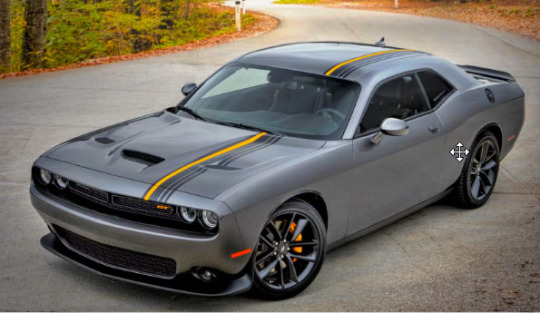
New Post has been published on https://fastmusclecar.com/beginners-guide-to-muscle-cars-handling-all-that-raw-power-safely/best-muscle-cars/
Beginner's Guide to Muscle Cars: Handling All That Raw Power Safely
Muscle cars epitomize cool with their iconic supercharged design. Yet controlling all that growling power poses real challenges, especially for novice drivers. Learning fundamental skills separates fun thrill rides from dangerous fishtails.
This guide distils beginner-friendly handling advice for harnessing muscle cars confidently. With defensive driving basics from 5-hour pre-licensing courses plus supplemental resources, newcomers can tame these beasts responsibly.
Muscle Car Basics
Before hitting the gas, understand what makes muscle cars unique using this glossary:
Rear-Wheel Drive (RWD): Engine output powers just the rear tires, enabling wild drifts but increased oversteer risk.
Torque: Twisting force to accelerate, reaching 400 lb-ft or more on many models for neck-snapping getaways.
High Power-to-Weight: Over 400 horsepower shoved into moderate chassis weight jacks straight-line speed through the roof.
Stiff Suspension: Firmer shocks and springs for better launches off the line. But bumpier rides with loose handling if you hit corners too hot.
Temperamental Throttle: Sensitive gas pedals make modulation tricky. Goose it too hard and easily break traction.
With great speed potential comes little room for error. Respect is essential for safely harnessing everything under the hood.
Proper Muscle Car Mindset
Channel patience and self-discipline behind the wheel above all else. Muscle cars actively punish hot dogging. Follow three core principles to avoid OCTM (overconfidence trouncing muscle):
1. Respect the Power Band
Never underestimate the explosive power band. Even veteran drivers get caught out by a twitchy throttle blipping them to triple digits faster than expected.
The inability to restrain the urge to floor it remains the number one cause of crashes. Internalize that showing off leads to expensive wrecks or reckless tickets at best.
2. Master Low-Speed Control
Get truly comfortable with slow-speed maneuvering before trying any Fast and Furious movies. Unlike regular cars, muscle models need extra finesse to avoid stalls thanks to all that torque.
Perfect pulling away smoothly, reversing in parking spots, and running through the gears at moderate RPMs before attempting speed runs and skipping this foundation courts disaster.
3. Seek Continued Education
Consider yourself always learning with these highly-tuned machines. Sign up for advanced defensive driving teachings to polish handling instincts beyond basic qualifications.
Never grow overconfident in your abilities, as that is when mistakes happen. The masters continue honing their craft years into ownership.
Defensive Driving Principles
While tempted to pound the throttle, prudent novices should enroll in 5-hour pre-licensing driving academy courses focused on muscle car safety.
These classes reinforce cautious habits for public roads. Reflect on the core topics regularly even after completing the curriculum:
Oversteer prevention: Smoothly managing RWD power distribution avoids unstable slip angles from acceleration or turning forces.
Braking distances: Increased velocity compounds stopping distances. Give yourself ample room to slow in time.
Steering inputs: During weight transfers, gentle adjustments maintain more control than jerky sawing at the wheel.
Highway merging: Find large gaps for merging onto fast traffic flow without disrupting stability.
Weather factors: RWD loses traction easier on wet or icy pavement. Tread extra carefully.
Peripheral vision: Continuously scan side and rear views to spot other motorists quickly amid velocity.
Consciously implementing these defensive practices keeps rides smooth while engraining vital muscle memory for reacting to hazards.
Supplemental Resources
While essential for initial guidance, 5-hour pre-licensing classes merely scratch the surface given muscle cars’ extreme performance capabilities.
Dedicate time to build advanced competence through supplemental education channels like:
Professional one-on-one lessons – Instructors individually assess strengths and weaknesses, providing customized coaching.
Autocross tracks – Practice cornering, braking, and accident avoidance on closed courses in a safe, controlled environment.
ASTMuscleCar online portal – This multimedia website hosts an extensive video library demonstrating advanced exercises like drifting, collision prevention, and more.
The combination of a structured pre-licensing curriculum, experiential learning at driving centres, and ASTMuscleCar’s on-demand resources delivers well-rounded abilities for muscle car mastery.
Open Roads and Endless Possibilities Await
Muscle cars exemplify aggressive individualism. Yet successfully navigating their temperamental handling and stratospheric speed potential relies on cultivating restraint and discipline.
The basics taught in 5-hour pre-licensing defensive driving courses must lay the groundwork. Supplementary hands-on practice and multimedia guides like ASTMuscleCar build advanced capabilities steadily over time for await anyone daring to tame these iconic beasts.
With an incremental learning plan in place, that evocative growl passing viewers on the highway soon plays as the soundtrack of your own thrilling muscle car road adventures. Now cue up Radar Love and hit the gas wisely!
0 notes
Text
How to build biking habits for a kid
Building biking habits for a kid can be a fun and healthy way to introduce them to physical activity and outdoor adventures. Here are some steps to help you encourage biking habits in children:
Choose the Right Bike: Ensure that your child has a bike that fits them properly. It should not be too big or too small. Proper fit is essential for comfort and safety.
Safety First:
Make sure your child wears a helmet every time they ride.
Teach them the basic rules of the road and the importance of following traffic signs and signals.
Check that the bike has working brakes and reflectors. Add lights if they will be riding in low-light conditions.
Lead by Example: Kids often emulate their parents or older siblings. If you regularly ride a bike, it can motivate your child to do the same.
Start Early: The earlier you introduce biking, the easier it is for kids to adopt it as a habit. Many children start with a balance bike (a bike without pedals) to learn balance and coordination before transitioning to a pedal bike.
Gradual Progression: Begin with short rides and gradually increase the distance as your child becomes more comfortable and confident. Make sure the routes are age-appropriate and safe.
Family Outings: Plan family bike outings to parks, trails, or other scenic locations. Make these trips enjoyable and memorable experiences.
Fun Accessories: Let your child choose fun accessories for their bike like a bell, a basket, or colorful streamers. This personalization can make biking more exciting.
Set Goals: Help your child set achievable biking goals. This could be a certain distance they want to reach, mastering a specific skill (e.g., riding with no training wheels), or participating in a family bike race.
Create a Routine: Establish a routine for biking. Whether it's a daily ride after school or a weekend family ride, consistency helps build habits.
Join a Group: Look for local biking clubs or groups for kids. Riding with peers can be motivating and a great way for kids to make friends who share their interests.
Reward System: Consider implementing a reward system to encourage regular biking. For example, your child could earn rewards for completing a certain number of rides or hitting a distance milestone.
Safety Check: Teach your child basic bike maintenance and safety checks. This includes checking tire pressure, ensuring the brakes work, and keeping the chain lubricated.
Make it Fun: Keep the focus on fun and adventure rather than exercise. Plan scavenger hunts, treasure hunts, or themed rides to make biking enjoyable.
Stay Positive: Encourage and praise your child's efforts, whether they are just starting or improving their skills. Positive reinforcement goes a long way in building habits.
Stay Involved: Continue to ride with your child and show your interest and enthusiasm. Ask them about their biking adventures and listen to their stories.
Remember that every child is different, so be patient and adjust your approach based on their interests and comfort level. The goal is to make biking a lifelong habit that they enjoy.
0 notes
Photo

New Post has been published on https://www.vividracing.com/blog/ebc-brakes-releases-what-might-be-the-best-brake-kit-for-the-honda-civic-type-r-fk8/
EBC Brakes Releases What Might Be The Best Brake Kit For The Honda Civic Type R - FK8
We have good news for the owners of the Honda Civic Type R (FK8) from EBC Brakes, a leader in manufacturing rotor brake components. The company’s latest release is meant to improve your Honda Civic Type R’s stopping power in an astonishing way. We at Vivid Racing are committed to giving you the best products and recommendations that improve your car’s driving characteristics, so we are happy to let you know that the EBC Brakes Racing 6-Piston Apollo Big Brake Kit is now available in our shop and can be bought by clicking the links below.
One doesn’t need much convincing as to why this is the best upgrade for their high-performance Honda Civic Type R (FK8). The car is perfect as a road/track sports car with a powerful engine, and enhanced handling capabilities, with outstanding features like those, a brake upgrade will only deliver maximum braking performance and bring out the best driving experience by;
improving braking performance and reducing brake fade during track use
effective heat dissipation
aesthetics purposes
giving the car a firmer and more responsive brake pedal feel
The EBC Brakes Racing 6-Piston Apollo Big Brake Kit for the Honda Civic Type R (FK8) is proudly engineered in the UK, and it comes complete with all the hardware needed to replace your stock braking system.
Kit Includes:
6 Piston front calipers
380mm Fully floating two-piece rotors
Front Bluestuff™ NDX pads
Front braided lines
All fluid/fixtures required
Features: Apollo Series 6 Piston Calipers
EBC’s lightweight-yet-strong aluminum 6-piston brake caliper
Two-piece bolted design that incorporates high-tensile 12.9-grade steel bolts for reinforcement of the caliper bridge section (computer FEA analysis shows that this offers significant improvements in caliper stiffness compared to a monobloc design)
Machined from heat-treated low-pressure castings (this offers a noticeable performance advantage over conventional gravity cast calipers, exhibiting higher overall strength and a comparable caliper body stiffness to forging)
High-temperature fluid seals coupled with full boot-type dust seals give maximum protection against road grime and debris-Lightweight, hard-anodized aluminum staggered pistons with serrated/castellated piston noses that reduce heat transfer into the braking hydraulics
Every single brake caliper pressure tested to 2,500psi
Full stainless-steel hardware and fittings, providing durability and longevity–this caliper will never rust
Uses standard pad shapes, giving choice when selecting brake pads
Rather than a powder-coated finish, all Apollo calipers use an advanced high-temperature Teflon™ polyester coating process to ensure they look great for much longer. Currently available in Stealth Black, Storm Shadow Blue, Luminous Yellow, and Racing Red
Features: Fully-Floating Two-Piece Rotors
Fully-floating 380x36mm two-piece rotors that allow the outer ring to expand freely in response to heat (this reduces stress which in turn extends rotor life and reduces the tendency for rotor cracking during extreme use)
Drive bobbins machined from a single piece of stainless steel giving maximum strength and corrosion resistance (this reduces maintenance requirements and ensures the outer ring continues to float freely over time)
Rotor rings feature 48 directional internal curved vanes for improved cooling
Unique ‘Swept Groove’ slot design for effective evacuation of braking dust and gases whilst ensuring good initial bite on brake application
Now featuring the latest thermic black corrosion-resistant finish–the very latest in rust prevention
Features: Bluestuff™ NDX Performance Brake Pads
Every EBC 6-piston Apollo Big Brake Kit is supplied with EBC Bluestuff™ NDX pads for the front axle
Now road legal in most markets, Bluestuff™ NDX combines excellent cold bite with the capability to perform well in short spells of track/race conditions
Features: Stainless Steel Braided Brake Lines
Every kit is supplied with EBC Brakes’ stainless-steel braided brake lines for the front axle
Every hose has a stainless-steel braided exterior that prevents a phenomenon known as ‘ballooning’, this braided exterior prevents the spongey feel of OE rubber lines and provides greater precision and feel under braking
Features: Super DOT 4 Brake Fluid
Every kit is supplied with 1 litre of BF307+ super DOT 4 brake fluid. This fluid has a 310°C boiling point–a significantly higher boiling point than standard DOT 5.1 fluid
Having such a high boiling point gives the braking system exceptional endurance, allowing you to push hard for extended periods without heat soak causing the fluid to boil and resulting in a fade
CLICK HERE to buy the EBC Brakes Front S25 Kits Redstuff & SG2F Rotors Honda Civic Type R 2.0 Turbo Petrol 2017-2023
CLICK HERE to buy the EBC Brakes Front S27 Kits Bluestuff Pads & SG2F Rotors Honda Civic Type R 2.0 Turbo Petrol 2017-2023
CLICK HERE to buy the EBC Brakes Front S26 Kits Yellowstuff & SG2F Rotors Honda Civic Type R 2.0 Turbo Petrol 2017-2023
CLICK HERE to buy the EBC Brakes Front S30 Kits RP-X Race Pads & SG2F Rotors Honda Civic Type R 2.0 Turbo Petrol 2017-2023
CLICK HERE to buy the EBC Brakes Front S29 Kits RP-1 Race Pads & SG2F Rotors Honda Civic Type R 2.0 Turbo Petrol 2017-2023
CLICK HERE to buy the EBC Brakes Racing Rear 305mm SG Series Sport Disc Rotors (Pair) Honda Civic Type R 2.0T 2017-2023
CLICK HERE to buy the EBC Brakes Pair Rear SG Series Sport Discs Honda Civic Type-R 2017-2021
#6-Piston Apollo Big Brake Kit for the Honda Civic Type R (FK8)#Apollo Big Brake Kit#EBC Brakes Racing#EBC Brakes Racing Brake Kit for the Honda Civic Type R (FK8)#Honda Civic Type R (FK8)#Honda Civic Type R (FK8) brake upgrades
1 note
·
View note
Text
Powerstage RR Limited Edition: The first carbon-framed Ducati e-MTB


The e-MTB range for 2024 expands with the introduction of the Powerstage RR Limited Edition, Ducati's most exclusive e-enduro model developed to tackle the most extreme off-road conditions. The name Powerstage, in fact, recalls a new type of special stage recently introduced in the e-enduro circuits which consists in tackling, in addition to the classic downhill stages, a technical uphill route, testing both the skills of athletes competing in the races and the performance level of the vehicle. Powerstage RR Limited Edition is a concentration of technology and advanced components, defined by eliminating compromises with the aim of offering maximum performance. The "full carbon" frame has undergone lengthy testing on the toughest routes with a single goal: to guarantee maximum performance in the enduro field. The choices on the arrangement of the carbon layers and on the types of fibre intertwining are the result of FEA (Finite Element Analysis) which allows to identify the points subject to greater stress, which therefore require greater strength. More attention to stiffness has been given to the steering area, the rear chain stay and the engine area reinforced by two ribs (T-Ribs). On the frame there are many other high-quality functional details, such as the passage of internal cables, protected by a steering stop system (T-Stopper), bearings on the joints, in direct contact with the carbon without the use of bushings and an asymmetrical rear chain stay, which in addition to a captivating design offers better responsiveness and uphill traction. The geometric solutions adopted make the Powerstage RR extremely fast and stable on the roughest routes. The verticalised 78° seat tube angle allows the rider to assume an optimal position in the saddle on technical uphill sections, and a slack 64° head tube angle helps to overcome any obstacle at top speeds.
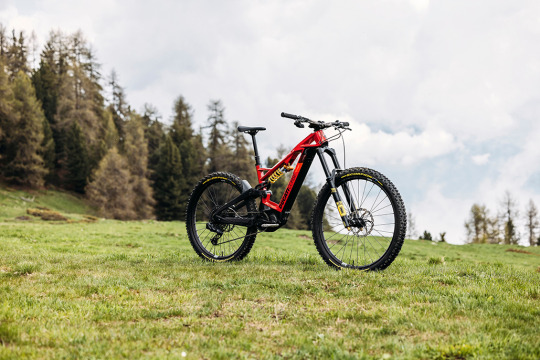
The new Shimano EP801 drive unit represents a benchmark for the category and maintains the native characteristics of the EP8: 250 Watts of nominal power and 85 Nm of torque, always delivered with the utmost fluidity and naturalness over a wider cadence range than ever before. The new system features two preconfigured assistance profiles: "long ride", to favour autonomy on long tours and "fast ride", to enjoy maximum performance on shorter outings. By means of the "Fine Tune" mode present on the Shimano "E-Tube Project" app, it is possible to create your own profiles thanks to the extensive possibilities for customising the electric assistance. The removable 630Wh Shimano battery is positioned inside the "verticalised" downtube in order to lower the centre of gravity, improving the balance of the bike. The Öhlins RXF38 m.2 air fork (180 mm travel) and the Öhlins m.2 spring shock absorber with TTX technology (170 mm travel) are fully adjustable in both rebound and compression, at high and low speeds, ensuring precision riding and stability. The SRAM GX AXS 12-speed wireless rear electronic shifting provides immediate and precise gear-shifts at all times. The Braking First brakes with customised Ducati Corse levers and 203 mm thick 3 mm discs are among the most powerful currently on the market. The Crankbrothers Synthesis wheels with differentiated format (29” front, 27.5” rear) with variable thickness carbon rims help to further improve steering precision, guaranteeing an excellent weight/strength ratio. The tyres are Pirelli Scorpion Enduro S on the front and Pirelli Scorpion EMTB-S on the rear to offer maximum grip and adherence. The equipment is completed by a telescopic seat post, a Renthal carbon handlebar and a Fizik saddle with special integrated tool holder.

Giorgio Favaretto, Head of e-Bicycle Business – “Ducati’s pedal assisted bicycle project took shape with the launch of the MIG-RR, the first e-mtb produced in collaboration with Thok E-Bikes. In 2022 the range of E-Bikes has been made even more complete and performing. Today, with the new Powerstage RR, Ducati strengthens its presence in the premium-range e-mountain bike segment, aimed at even more demanding bikers." The livery designed by Aldo Drudi in collaboration with the Centro Stile Ducati is inspired by the Desmosedici GP23 of the official MotoGP team, enhancing the unique character of this e-mtb produced in a limited edition of 230 numbered units, a figure that recalls the denomination of the racing bike. The new Powerstage RR Limited Edition will be previewed in the paddock area during the upcoming German Grand Prix at Sachsenring and can already be ordered from the Ducati dealer network and online at www.ducati.com. The Borgo Panigale manufacturer is gearing up to welcome all enthusiasts from 21 to 25 June at Eurobike (Frankfurt, Pavilion 8, stand I03) with the 2024 e-Bicycle range. For more Ducati news check out our dedicated page Ducati UK News or head to the official Ducati UK website ducati.com/gb/en/home
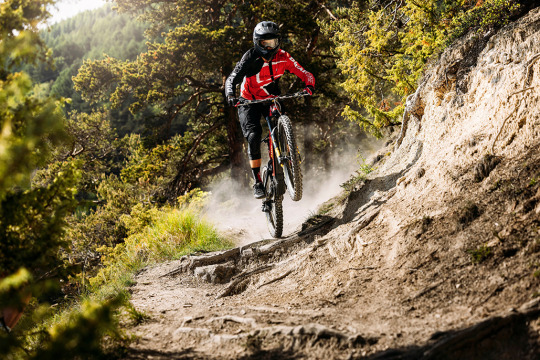
Read the full article
0 notes
Text
Discover the Best Bike Riding Lessons Near You
Are you keen to pick up new talents or learn how to ride a bike? Finding bike riding lessons near me is the perfect starting point. Whether you’re a beginner or looking to refine your techniques, local lessons can cater to your needs.

Importance of Bike Riding Lessons
Learning to ride a bike is more than just picking up a skill; it’s about building confidence, enhancing fitness, and enjoying the outdoors. Bike riding lessons near me can provide structured guidance tailored to your needs. With an experienced instructor, you’ll learn safe riding practices, balance, and navigation techniques in a supportive environment.
Benefits of Local Bike Riding Lessons
Personalized Instruction
One of the key advantages of taking local bike riding lessons is the personalized instruction you receive. Instructors can tailor lessons to your skill level, whether you’re a first-time rider or someone looking to master advanced techniques. This one-on-one attention makes a significant difference in your learning experience, ensuring that you progress at a pace that feels comfortable.
Community Engagement
Joining local lessons connects you with fellow cycling enthusiasts. This sense of community not only makes learning more enjoyable but also fosters friendships and camaraderie. Engaging with others who share your passion can motivate you to ride more and participate in group activities, such as community rides and events.
Convenience
Finding Bike riding lessons near me means less travel time and more flexibility in scheduling. Local lessons fit easily into your routine, allowing you to focus on improving your skills without the hassle of long commutes. You are motivated to dedicate yourself to your classes and practice more frequently by this convenience.
What to Expect in Your Lessons
Initial Assessment
When you sign up for bike riding lessons, instructors typically start with an assessment of your current skills. This helps them understand your strengths and areas for improvement, allowing them to tailor the lessons specifically to your needs. Knowing where you stand helps set realistic goals for your progress.
Emphasis on Safety
Safety is paramount in bike riding, and instructors will make sure you understand this from the very beginning. Expect to learn about helmet use, traffic rules, and safe riding practices. You'll gain knowledge on how to handle different scenarios you might encounter on the road, which is essential for becoming a confident cyclist.
Basic and Advanced Skills
For beginners, lessons focus on balancing, pedaling, and steering. The development of these fundamental abilities is essential for riding with confidence. If you already have some experience, expect lessons on advanced techniques such as cornering, braking, and navigating obstacles. You may also learn how to ride on different terrains, from urban environments to rugged trails.
Practice Opportunities
Most lessons will include plenty of practice time. Instructors will encourage you to ride as much as possible to reinforce what you’ve learned. Regular practice helps solidify your skills, making you a more competent and confident rider over time.
How to Find the Right Lessons
Searching for Bike riding lessons near me can lead you to a variety of options:
Check Online Reviews: Seek out reputable local trainers or riding schools in your area. Feedback from past students can provide insight into the quality of instruction and the overall experience you can expect.
Ask for Recommendations: If you know other cyclists, don’t hesitate to ask them about their experiences. Personal referrals often lead to great local options, and you can benefit from the insights of those who have already gone through the learning process.
Visit Local Bike Shops: Many bike shops offer lessons or can recommend qualified instructors. They often have connections with the cycling community and can point you toward reputable options in your area.
Consider Group vs. Private Lessons
Decide whether you prefer one-on-one attention or learning in a group setting. Each has benefits, so pick the one that feels most appropriate for you. Group lessons can be fun and social, while private lessons offer more focused attention.
Learning to ride a bike can be a rewarding journey. By seeking out Bike riding lessons near me, you’re taking the first step toward mastering this valuable skill. With the right guidance, you’ll enjoy the freedom and joy that cycling brings. So why wait? Start your biking adventure today and discover all the benefits it has to offer!
#Bike riding lessons near me#NYC Private Sport Training for Kids#Private Sports Lessons for Kids NYC#Private Sports Lessons for Kids#NYC Private Multi Sport Training for Kids#Customize multi-sport training classes for kids#Group bike lessons for children nyc#Childrens sports and fitness classes brooklyn#Bike riding lessons for children and adults nyc#NYC bike riding classes for kids#Sports Lessons for Kids NYC#Group bike riding for children nyc#Bike riding for adults in NYC#Group bike lessons for adults nyc#Bike rides for children and adults brooklyn
0 notes